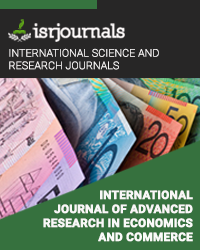the impact of trade liberalization on balance of payments ofethiopia
Syed Hasan Qayed,
Published in International Journal of Advanced Research in Economics and Commerce
ISSN: xxxx-xxxx Impact Factor:xx Volume:1 Issue:1 Year: 08 June,2013 Pages:45-53

Abstract
This study examines the impact of trade liberalization on the Ethiopia’s balance of Payment using the data over the period from 1981to 2012.In order to capture the partial effects of trade liberalization on the balance of payments different variables were included into the model and long run and short run relationships were analyzed with the use of ordinary least square (OLS) method and Error Correction Method (ECM) respectively. The results of the study show that the trade liberalization dummy variable and terms of trade variable is statistically significant and negative, implying that the trade liberalization deteriorates the balance of payments. Therefore in order to mitigate this negative impact and to ensure that trade liberalization will increase both the growth of exports and imports and consequently improve welfare, the government should complement the trade liberalization with a well designed macroeconomic reforms along with specific conditionalities.
Kewords
Balance of Payments,Ethiopia,TradeBalance,TradeLiberalisation
Reference
Ahmed, N.U.,( 2000), “Export Responses to Trade Liberalisa-tion in Bangladesh: A Cointegration Analysis”, Applied Economics, Vol.32, pp.1077–84. Bertola, G. and Faini, R., (1991), “Import demand and non-tariff barriers the impact of trade liberalization”, Journal of Development Economics, 34(1-2):269-286. Bleaney, M., (1999), “Trade Reform, Macroeconomic Performance and Export Growth in Ten Latin American Countries, 1979–95”, Journal of International Trade and Economic Development, Vol.8, No.1, pp.89–105. Deverajan, S. and Rodrik D. (1989), “Trade Liberalization in Developing Countries: Do Imperfect Competition and Scale Economics Matter”? American Economic Association. Dornbusch, R. (1992), “The case for Trade Liberalization in Developing Countries”,Journal of Economic Perspectives, Vol. 6, No. 1 pp. 69-85 Greenaway, D. and D. Sapsford, (1994), “What Does Liberalisation Do for Exports and Growth”, Weltwirtschaftliches Archive, Vol.130, No.1, pp.152– 74. Helleiner, G.K., (Ed.), (1994), “Trade Policy and Industrializa-tion in Turbulent Times”, London and New York: Routledge. Jenkins, R.,( 1996), “Trade Liberalisation and Export Performance in Bolivia”, Development and Change, Vol.27, No.4, pp.693–716 Jenkins R. (1997), “Trade Liberalization in Latin America- The Bolivian Case”, Bulletin of Latin American Resarch, Vol. 16 No. 3 Joshi, V. and I.M.D. Little, (1996), “India’s Economic Reforms 1991–2001”, Oxford: Oxford University Press Khan M.S. and Zahler, R. (1985), “Trade and Financial Liberalization Given External Shocks and Inconsistent Domestic Policies” , IMF Staff paper, Vol. 32 (March ), IMF Lopez, P. (2005), “The Effect of Trade Liberalization on Exports, Imports, the Balance of Trade and Growth: the Case of Mexico”, Journal of Post Keynesian Economics, Vol. 27 No. 4 Melo, O., and Vogt, M. G.,(1984), “Determinants of the demand for imports of Venezuela”, Journal of Development Economics, 14(3):351-358 Milner, C. (1990), “The Role of Import Liberalization in Export Promotion: Export Promotion Strategies- Theory and Evidence from Developing Counties, edited by C .Milner, PP. 81- 88. Harvester/ Wheatsheaf, London. Melo, O., and Vogt, M. G.,(1984), “Determinants of the Demand for Imports of Venezuela”, Journal of Development Economics, 14(3):351-358 MoFED, (2006),”Ethiopia Building on Progress. A Plan for Accelerated and Sustain Development to End Poverty (PASDEP)”,Volume 1: Main Text. Ministry of Finance and Economic Development (MoFED), Addis Ababa NBE (National Bank of Ethiopia), various years’ Quarterly Bulletins and Annual Reports. Nishmizu, M and Robinson, S. (1984),“Trade Policies and Productivity Change in Semi –Industiralised Countries”,Journal of Development Economics, Vol. 16 pp. 177-206 Ocampo, J and Trylor , L. (1998) , “Trade Liberalization in Developing Economies: Modest Benefit but Problems with Productivity Growth, Macro Prices, and Income Distribution”, The Economic Journal, Vol. 108 No. 450 Ostry, J . (1991), “Trade Liberalization in Developing Countries- Initial Trade Distortions and Imported Intermediate Inputs”, Staff paper- International Monetary fund, Vol. 38 No.3, IMF Ostry, D.J., and Rose, A.K., (1992), “An empirical evaluation of the Macroeconomic Effects of Tariffs”,Journal of International Money and Finance, 11(1):3- 79 Pack,H.(1991), Learning and Productivity change in Developing Countries: Trade Policy,Industrialization and Development-A Reconsideration, edited byG.Helleiner,PP21-45,Clarendon Press, Oxford Parikh, A., (2006), “Relationship between trade and liberalization, growth and Balance of Payment in Developing Countries: An Econometric Study”, International Trade Journal, 20(4):429-467 Paulino, A. and Thirlwall, A (2004), “The Impact of Trade Liberalization on Exports, Imports and the Balance of Payments of Developing Countries”, The Economic Journal, Vol. 114, No. 493 Rodrik, D., (2006). “What’s so special about China’s exports?” China & World Economy, 14(15), September-October, 2006, 1-19. Sachs, J.D. and A. Warner (1995), “Economic Reform and the Process of Global Integration”, Brookings Papers on Economic Activity 1995 (1): 1-118 Santos-Paulino, A and A. P. Thirlwall.,(2004), “The Impact of Trade Liberalization on Exports, Imports and the Balance of Payments of Developing Countries," Economic Journal, Royal Economic Society, 114(493), F50-F72, 02 Svedberg, P., (2000),The Export Performance of Sub-Saharan Africa.: Trade and Development in Sub-Saharan Africa,edited by Frimpong-Ansah J.H, S.M.R.Kanbur and P.Svedberg ,Manchester University Press, Manchester. Thomas, V., Nash, J. and S. Edwards, (1991), “Best Practices in Trade Policy Reform”, Oxford: Oxford University Press for the World Bank UNCTAD, (1999),”Trade and Development Report”, Geneva: UNCTAD Verbeek, M. (2004), “A Guide to Modern Econometrics”, second Edition, John Wiley & Son Ltd. Wacziarg, K. H. (2008), “Trade Liberalization and Growth: New Evidence”, The World Bank Economic Review, 22(2): 187-231. World Bank

